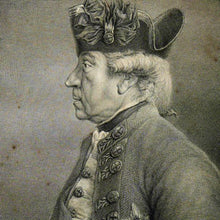Engraving - Sir Robert Boyd, Governor of Gibraltar, 1789
- Regular price
- £475
- Sale price
- £475
- Regular price
-
- Unit price
- /per
Adding product to your cart
Overall: 50cm (19.5in) x 56cm (22in)
Line engraving on paper. Quarter length profile portrait in uniform of Lieutenant-General Sir Robert Boyd (1779-1833), Governor of Gibraltar, engraved by John Hall, engraver to His Majesty, after Antonio Poggi. Published London 1789. Framed and glazed.
Lieutenant-General Sir Robert Boyd (1710-1794) was born at Richmond, Surrey and attended the University of Glasgow before entering the Army. In 1756 he served at the Siege of Minorca, and attempted to reach Admiral John Byng's fleet in an open boat with a message from the besieged garrison commander, William Blakeney. Boyd was a witness at the subsequent court-martial at which Byng was tried for the loss of the garrison. He subsequently became commissary general to the Marquess of Granby in Germany (1758 to 1759). He was afterwards three times Governor of Gibraltar and considered that his on the King's Bastion in Gibraltar was so important that he asked to be buried there. The site of his burial is lost under cement but a marble memorial in the King's Bastion reads:
‘Within the walls of this bastion are deposited the mortal remains of the late General Sir Robert Boyd, K.B., governor of this fortress, who died on 13 May 1794, aged 84 years. By him the first stone of the bastion was laid in 1773, and under his supervision it was completed, when, on that occasion, in his address to the troops, he expressed a wish to see it resist the combined efforts of France and Spain, which wish was accomplished on 13 Sept. 1782, when, by the fire of this bastion, the flotilla expressly designed for the capture of this fortress were utterly destroyed.’






